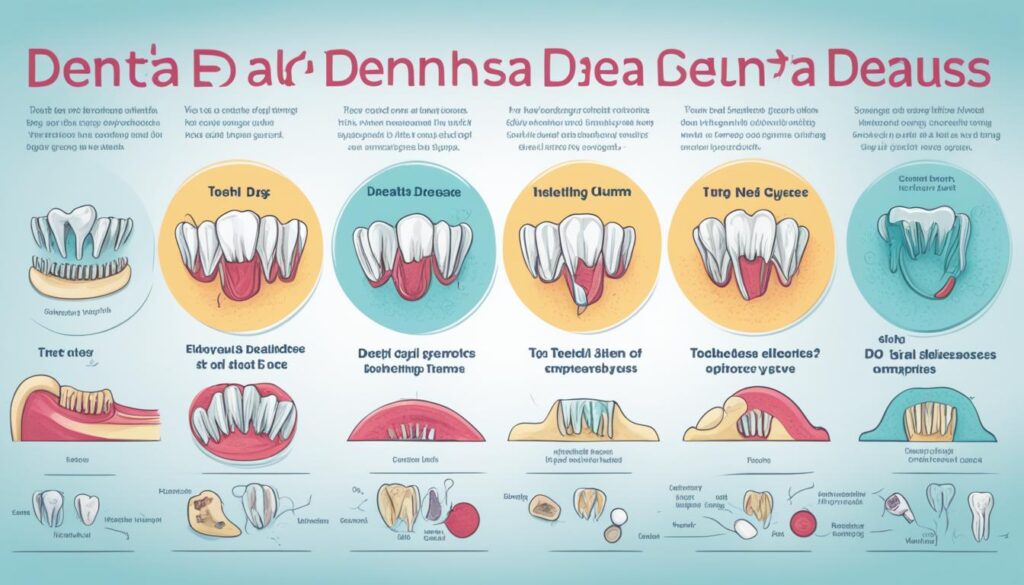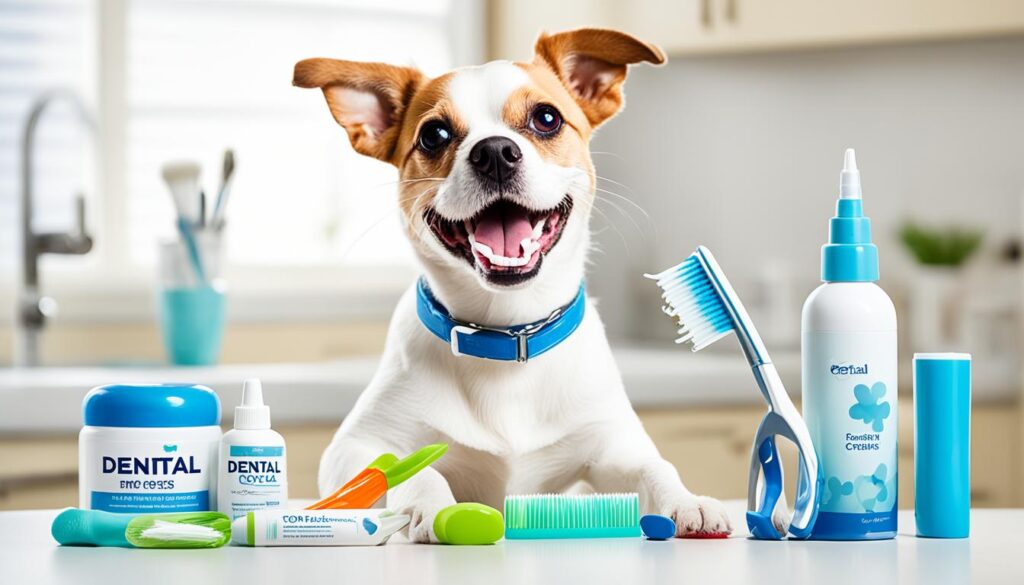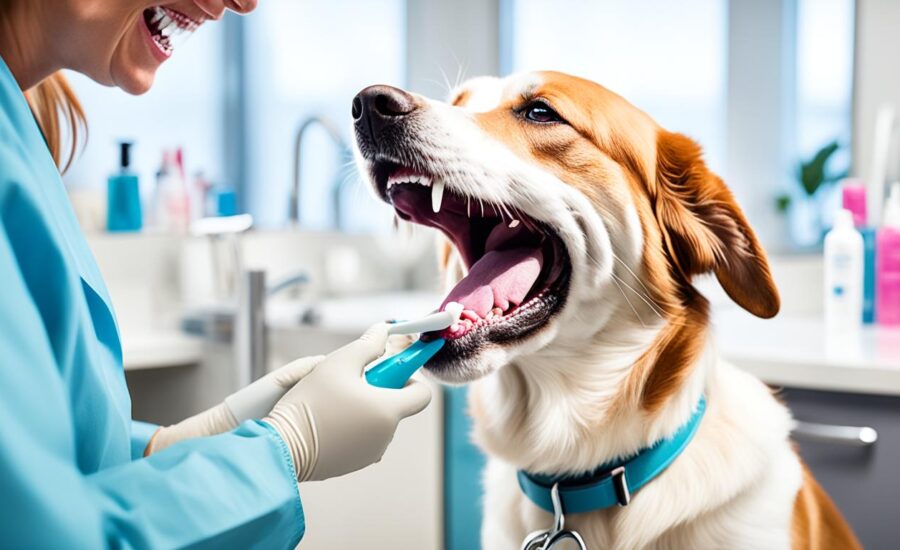A pet’s shiny coat can easily steal the spotlight, leaving their dental care unnoticed. Grooming is about more than just looks—it’s crucial for a pet’s optimal health. The importance of dental hygiene in grooming is often overlooked, despite it being key to happier pets. A sleek coat doesn’t always mean the pet is healthy. Ignoring dental care can lead to serious oral diseases that harm their well-being. Integrated dental care in grooming not only enhances their fur’s shine but also promises a joyous, pain-free life for our four-legged friends.
By focusing on dental hygiene in grooming, we can catch early signs of trouble in our pets’ mouths, whether their teeth are white or not. Every brush, clip, and clean is a chance to improve their health through their mouths. Paying close attention to dental care can protect them from harmful oral diseases.
Key Takeaways
- Recognize the significance of integrating dental care focus into your regular pet grooming regimen.
- Understand that pet dental hygiene is integral to maintaining happier pets and their optimal health.
- Learn that a well-groomed coat is not always an indicator of good health—oral care is equally important.
- Discover the potential health risks associated with the neglect of dental hygiene in pets.
- Adopt a holistic approach to pet grooming that includes regular dental check-ups and teeth cleaning.
The Importance of Dental Care in Pet Grooming
Pet grooming does more than keep coats shiny. It’s also key to good dental health for our animal friends. As pet owners buy the latest grooming and health products, knowing about pet dental care is vital. Cleaning your dog’s or cat’s teeth does more than stop bad breath. It prevents health problems that start in the mouth.
Understanding Canine and Feline Dental Anatomy
Each tooth in your pet’s mouth serves a unique role. From nibbling with incisors to grinding with premolars and molars. These teeth and healthy gums are crucial for preventing canine periodontitis and maintaining oral health. Recognizing this helps fight dental disease and keeps your pet’s teeth healthy for life.
Identifying Common Dental Ailments in Pets
Periodontal diseases are among the most common dental problems in pets. They can cause gum inflammation and tooth loss. While less common, oral tumors in dogs are a serious risk that needs quick action. Owners should ensure their pets get regular dental check-ups as part of a thorough dental care strategy.
Link Between Oral Health and Overall Wellness
There’s a strong link between a pet’s oral health and their overall health. Early dental issues can indicate larger health troubles. So, periodontal disease in pets is a concern that goes beyond just oral health. Pet owners should include professional teeth cleaning for dogs and cats in their pet care routines.
- Regular dental check-ups for pets to assess for periodontal diseases.
- Yearly professional cleanings that cater to both canine dental care and feline dental care.
- At-home oral hygiene practices to complement the pet grooming and health regimen.
| Pet Dental Issue | Indicator | Potential Systemic Health Issues |
|---|---|---|
| Canine Periodontitis | Bad breath, bleeding gums, tooth loss | Heart, liver, and kidney diseases |
| Oral Tumors in Dogs | Growth in the mouth, difficulty eating | Potential malignancy leading to widespread illness |
| Feline Dental Disease | Drooling, pawing at the mouth | Immune system impacts, chronic pain, and behavioral changes |
Dental Diseases and Their Impact on Pet Health
Dental diseases in dogs can cause pain and discomfort. They also put your pet’s health at risk. An unhealthy tooth can let bacteria enter and lead to infections that may affect the heart, kidneys, and liver. Spotting the signs of dental disease early is crucial to stop these issues.
Cleaning your pet’s teeth often helps stop plaque and tartar, the main causes of dental issues. Besides grooming visits for professional cleanings, owners should also create a home care plan. This reduces the risk of gum disease and cavities.

Here’s a comparison to show why both professional and at-home dental care are important for your pets:
| Dental Care Aspect | Professional Grooming | At-home Care |
|---|---|---|
| Pet Teeth Cleaning | Thorough scaling and polish performed by professionals | Daily brushing with pet-safe toothpaste |
| Dental Health Monitoring | Regular check-ups to catch early signs of dental issues | Owner observes behavioral changes or signs of discomfort |
| Preventative Care | Application of sealants or fluoride treatments as necessary | Use of dental chews and water additives to reduce plaque |
Using both professional and home dental care is the best way to keep your pet’s mouth healthy. It also helps them live a longer, happier life.
Breed-Specific Dental Concerns and Care
Every pet’s dental health depends on their breed. Certain breeds have special dental challenges that need specific care. This helps keep their teeth healthy.
Small Breeds: Increased Risk of Periodontal Diseases
Dental care for small breed dogs deals with plaque and tartar build-up in pets. Their teeth are close which leads to more debris. Overcrowding in their mouths can also cause gum diseases. Cleaning their teeth regularly and home dental care are important to prevent these problems.

Large Breeds: Dental Wear and Trauma
Big dogs can have dental wear issues. This can make their teeth sensitive and damage their enamel. Chewing hard objects can hurt their teeth. So, it’s crucial to give them safe, strong toys to chew on. This prevents dental injuries.
Brachycephalic Breeds: Unique Challenges
Short-faced brachycephalic breeds face special dental hygiene challenges. Their short jaws can cause tooth misalignment. Standard dental care might not work well for them. Dental care for brachycephalic breeds needs to be adjusted for their needs.
| Breed Type | Common Dental Issue | Recommended Care |
|---|---|---|
| Small Breeds | Periodontal disease, tooth decay | Specialized dental techniques, regular check-ups |
| Large Breeds | Dental wear, cracked teeth | Safe chew toys, avoidance of hard materials |
| Brachycephalic Breeds | Teeth misalignment, breathing issues | Custom tools, careful monitoring |
Owners and groomers should customize their dental care for each breed. This ensures all pets can have a healthy mouth their whole lives.
Signs Your Pet May Have Dental Issues
Dental problems in pets show up in many ways. If your dog has bad breath, it’s not just a small issue. It could mean serious health problems. A strong, bad smell suggests your pet might need better dental care.
Watch how your pet acts for more clues. Here’s what to keep an eye on:
- Reluctance to eat or chew may suggest dental pain.
- Excessive drooling could signal an issue, especially if accompanied by blood.
- Pawing at the mouth is often a visible sign of dental discomfort in pets.
- Visible plaque or tartar build-up along the gumline can lead to serious issues if not addressed.
Taking good care of your pet’s grooming and health helps prevent dental issues. If you notice any symptoms, get advice from a vet right away.
| Sign of Dental Issues | Possible Causes | Recommended Action |
|---|---|---|
| Changed eating habits | Dental pain, tooth decay, or gum disease | Schedule a vet appointment |
| Bad breath | Build-up of bacteria, periodontal disease | Increase oral care routine |
| Difficulty chewing | Tooth loss, abscesses, or broken teeth | Consult veterinarian for oral examination |
| Swollen or bleeding gums | Periodontal issues, infection | Professional dental cleaning |
A Comprehensive Approach to Pet Dental Care
Keeping your pet’s teeth healthy is a team effort. It involves care at home and help from pros. A holistic pet dental care strategy means preventing problems before they start. It’s not just about fixing issues. This approach covers daily brushing and routine pet dental check-ups. This keeps dental diseases at bay.
- Daily brushing with vet-approved toothpaste to prevent plaque and tartar build-up.
- Using dental chews and toys that promote chewing for natural teeth cleaning.
- Offering a diet that supports dental health, possibly including special veterinary-recommended kibble that helps scrub teeth.
Home care plus professional dog teeth cleaning and check-ups make a full plan. Routine pet dental check-ups are very important. Vets can find and treat issues early on. This way, they stop small problems from getting worse.
Clients notice their pets are more lively and happy when they receive regular dental care. This shows how vital dental health is to a pet’s overall well-being.
Mix these actions into your pet’s care routine for a joyful and healthy friend. A bright smile will show their thanks. Taking steps early on in dental care saves your pet from pain later. It also saves you money on big treatments.
Innovations in Pet Dental Health Monitoring
The pet grooming industry is always getting better. Tools like Orastripdx are changing pet health monitoring. This top-notch device helps find early pet dental disease. It means we can act fast to help our furry friends. Pet owners really like the improved pet dental disease detection.
Finding dental problems early is crucial. Orastripdx makes it quick and easy to check pets’ teeth. It spots gum diseases that might not be obvious.
Orastripdx has brought big changes to pet mouth care:
- Immediate feedback on the pet’s dental health status
- Non-invasive process that ensures comfort for pets
- Visual indicators that help reinforce the importance of dental care to pet owners
- Supports groomers in advocating for regular veterinary dental check-ups
| Benefits of Orastripdx | Impact on Pet Health Monitoring |
|---|---|
| Early detection of oral health issues | Preventive care to avert advanced dental disease |
| User-friendly application in the grooming setting | Seamless integration into the grooming process |
| Enhanced communication with pet owners | Improved awareness and understanding of pet dental needs |
By using Orastripdx, groomers can improve their work. It raises the care level in the pet grooming industry. For those of us keen on pet health, it’s great to use these new tools. They help us care for our four-legged customers and their owners.
Emphasizing Dental Care in Pet Grooming Education
Professional groomers do more than make pets look good. They help keep pets healthy through pet grooming education. Teaching pet owner awareness about oral care is crucial. This means grooming is not just about the coat. Knowing the importance of pet dental care is key to having healthier pets. This is a job for both groomers and pet owners.
Groomers play a big role in pet health. They highlight the need for regular dental checks and alertness to oral problems. When owners understand how dental care affects their pets, they commit to good tooth brushing and using the right dental tools.
The aim is to prepare pet owners to take great care of their pet’s teeth at home. This encourages a proactive approach to health care. With help from groomers, we’ll see a future where pet owners know the importance of pet dental care. This promises a brighter future for pets everywhere.
FAQ
Why is dental care important in pet grooming?
What does canine and feline dental anatomy include?
What are some common dental ailments in pets?
How does oral health correlate with my pet’s overall wellness?
What can happen if dental diseases are left untreated in pets?
Are certain dog breeds more prone to dental problems?
What signs indicate my pet might have dental issues?
How can I adopt a comprehensive approach to my pet’s dental care?
What is Orastripdx and how does it contribute to pet dental health monitoring?
How can pet groomers educate owners about pet dental care?
Source Links
- https://hachidoggrooming.com/dog-dental-care-guide/
- https://www.petedge.com/blog/the-groomers-role-in-canine-oral-health-care/
- https://wintervilleanimalcare.com/pet-dental-care-winterville-nc/

